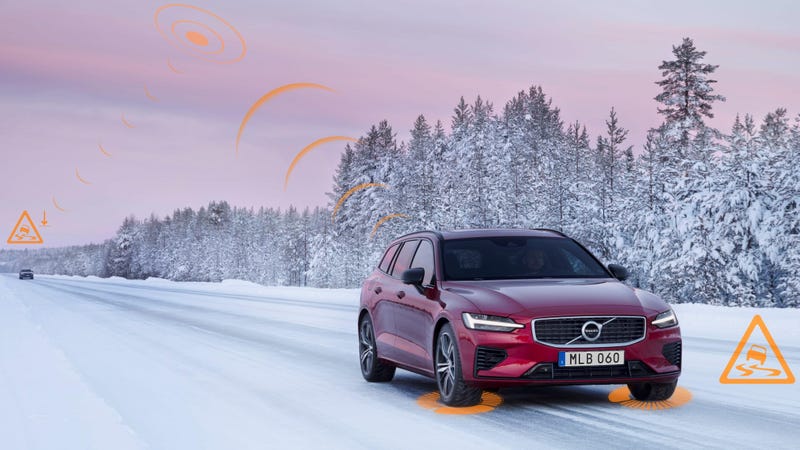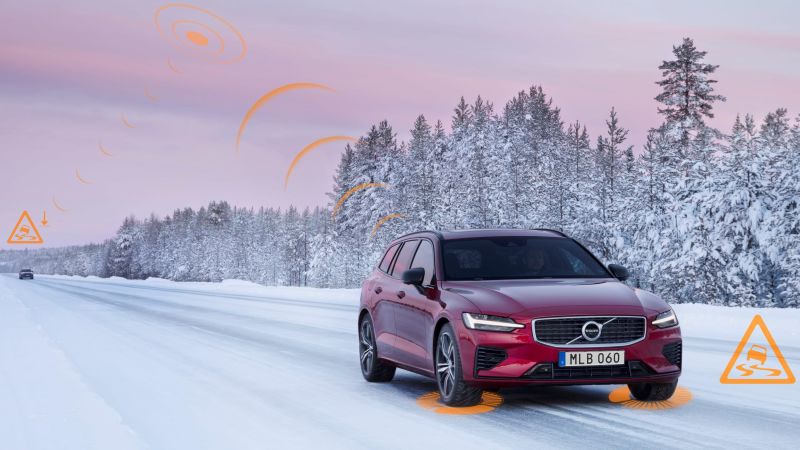
Volvo’s belief in safety is, in my experience, pretty sincere, even if it’s also an exercise in branding that has made it piles of money along the way. Still, its latest safety innovation has the potential to solve one of the biggest problems with cars today, even if it doesn’t go nearly far enough. The cars need to talk to each other, dammit.
Volvo has had what it calls Hazard Light Alert and Slippery Road Alert in its cars in Norway and Sweden since 2016. The system alerts other Volvos to potential hazards on the road in real time, by collecting anonymized data in vehicles and using that to signal to other Volvo drivers with the system equipped that there may be trouble ahead.
Volvo said Monday that the system would come standard in all of its cars from 2020 and beyond in Europe, a welcome expansion that hopefully means someday it might also come to the United States.
The system’s limitations are pretty meaningful—it only works in Volvos equipped with it, the number of which will be pretty small early on—but vehicle-to-vehicle connectivity like this is the kind of technology that all cars could have in the future, and not just for simple driver alerts.

Advertisement
If we’re ever going to get to full self-driving—I’m a bit skeptical we are, and certainly not the only one—it’ll be because we’ve finally figured out a way for cars to communicate with each other, much like airplanes do.
Privacy issues and lack of market incentive have curtailed efforts for anybody to develop this tech so far. But if your car is self-driving safely in some hypothetical future, it’ll be because it’s talking to every other car on the road at all times and it has even more information available to it than a human driver could ever interpret.
Companies like Tesla insist that they can build fully autonomous cars without such technology, but Teslas also keep crashing.
Advertisement
In that vein, probably the saddest part of Volvo’s press release Monday is this passage, possibly referring to Mercedes, which has its own vehicle-to-vehicle system on E-Classes:
With the launch of these features across Europe, Volvo Cars also reiterates its invitation to the car industry to join it in sharing anonymised data related to traffic safety across car brands.
Sharing such data in real time can provide a strong boost to overall traffic safety and becomes more influential the more cars are connected. Since last year, Volvo Cars and Volvo Trucks have shared data to alert drivers of nearby hazards in Sweden and Norway.
“The more vehicles we have sharing safety data in real time, the safer our roads become. We hope to establish more collaborations with partners who share our commitment to safety,” said Malin Ekholm.
[…]
Finally, the company announced that for the first time, it is making its safety knowledge easily accessible in a central digital library, which it urges the car industry to use in the interest of safer roads for all.
Advertisement
Volvo’s apparently out here like some chump, trying to make things better for everyone, but the other automakers are giving them a collective, “Eh.” Which means that this is an issue the government will likely have to get in on at some point. And before you say, “Don’t tread on me,” consider all the safety innovations governments have imposed in the past several decades, quite successfully–like seatbelts, backup cameras, and airbags.
Would automakers have voluntarily have done any of that shit if Big Government hadn’t told them to? Maybe! But I doubt it.













